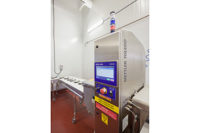Mettler-Toledo Introduces Advanced X-Ray For ‘Hard-to-Find’ Contaminants

The reliable performance of this new technology has been shown in tests conducted by Mettler-Toledo, in which a range of different foreign bodies were hidden in 650 gram packs of chicken breasts.
|
|
Mettler-Toledo Product Inspection launches its most advanced X-ray inspection technology to date, improving its ability to detect low density contaminants in packaged food products. The new technology will help food manufacturers avoid product recalls, reduce unnecessary product waste costs, and enhance product integrity and brand protection.
New Mettler-Toledo DXD and DXD+ dual energy detector technology is optimized for identifying foreign bodies such as calcified bone, low-mineral glass, rubber and some plastics. These types of contaminants are traditionally hard to detect within the “cluttered” or “noisy” X-ray images generated by overlapping and multi-textured products such as packs of pasta, chicken breasts, sausages, and frozen potato-based goods.
Such applications are a perfect match for DXD and DXD+ high-quality detector technology, in conjunction with new Mettler-Toledo Advanced Material Discrimination software tools. The software helps to separate and remove the prominent material of the food product within the X-ray image, revealing the presence of any lower density contaminants. As a result of the accuracy and reliability of DXD and DXD+ detection, food manufacturers can be more confident that their products are safe for consumers, and that they will benefit from reduced false reject rates and product waste, helping to deliver a fast return on investment.
The reliable performance of this new technology has been shown in tests conducted by Mettler-Toledo, in which a range of different foreign bodies were hidden in 650 gram packs of chicken breasts.
The new detector technology is available in two versions, giving customers two levels of dual energy X-ray performance:
- DXD: high-quality X-ray performance at an affordable price; can operate in the same environments as single energy solutions and can be used with line speeds typically up to 100 m/minute.
- DXD+: reliable detector technology for the most challenging applications; collects more data about the product being inspected, and improved image analysis software provides clearer images with higher resolution; DXD+ can be used with line speeds typically up to 45 m/minute.
“This is new technology meets a real demand in the market for X-ray inspection; it is capable of detecting low-density contaminants in a wide range of packaged food products,” said Gareth Jones, head of Engineering for Mettler-Toledo Product Inspection. “DXD and DXD+ provide high levels of detection in the most challenging applications our customers face. The benefits are both economic and reputational: they can better protect the integrity of their products and their brand, while also reducing cost and waste through improved false reject rates and less product throwaway.”
DXD and DXD+ dual energy detectors can now be specified with new purchases of Mettler-Toledo X36 X-ray inspection systems. Only a small amount of extra operator training is required due to automatic job set-up and the similarities between the Advanced Material Discrimination software and the ContamPlus software that is familiar to existing Mettler-Toledo X-ray users.
Mettler-Toledo is offering personalized consultations to prospective users of this latest technology either on a one on one basis at its Lutz facility or virtually. The consultations will include live testing with customers’ actual products, as well as the opportunity to engage with experts in the X-ray inspection field.
For more information, download a white paper here.
Looking for a reprint of this article?
From high-res PDFs to custom plaques, order your copy today!









